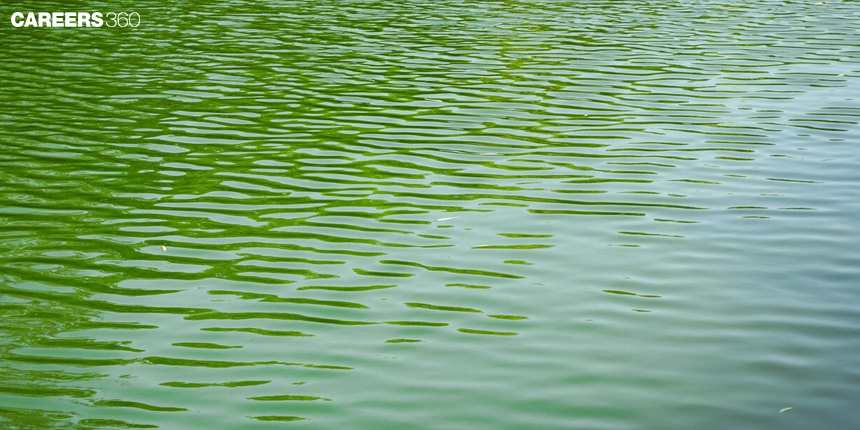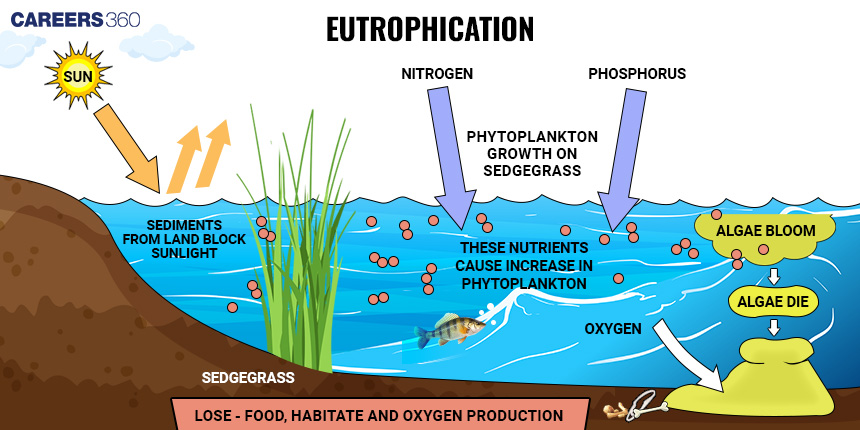Eutrophication: Definition, Causes, Classification, Types, Effects, Topics
What Is Eutrophication?
Eutrophication is a process in which water bodies such as lakes, rivers, and coastal areas are overly enriched with excessive nutrient loading, chiefly nitrogen and phosphorus. Consequently, this leads to the explosive growth of algae and other water plants, which may turn out ecologically to be unbalanced.
NEET 2025: Mock Test Series | Syllabus | High Scoring Topics | PYQs
NEET Important PYQ's Subject wise: Physics | Chemistry | Biology
New: Meet Careers360 B.Tech/NEET Experts in your City | Book your Seat now
- What Is Eutrophication?
- Definition Of Eutrophication
- Causes Of Eutrophication
- Eutrophication Diagram
- What Happens To The Vast Algal Biomass In Eutrophic Water?
- How Do Water Bodies Become Overly Enriched?
- Classification Of Eutrophication
- Process Of Eutrophication
- Effects Of Eutrophication
- Ecological Effects Of Eutrophication
- Mitigation And Control Measures
- The Video Recommended On Eutrophication:

Definition Of Eutrophication
Eutrophication is largely an anthropogenic process. Sources include agriculture, urban runoff, and industrial discharges of nutrients into aquatic systems. When the expression of nutrients into the water bodies is high, uncontrolled algal growths get stimulated to form algal blooms. Algal blooms can reduce the level of oxygen in water, causing hypoxia.
It is important to know eutrophication processes for aquatic ecosystem management and conservation, and this includes the identification of nutrient pollution sources and implementation measures for preventing or reducing their impacts. If not controlled, eutrophication can dramatically introduce ecological, economic, and social repercussions, such as decreases in biodiversity and populations of fish and the impairment of water quality and human health.
Causes Of Eutrophication
This primarily leads to eutrophication in water bodies, where there are abundant nutrients, especially nitrogen and phosphorus, caused by the excessive input. This is usually caused by runoffs from agricultural activities, wherein the cleaning of fertilisers and pesticides is washed off into the nearby streams or rivers. Nutrient pollution sources from within cities mainly come from sewage and industrial discharges. Eutrophication may also further be accelerated by atmospheric deposition of nitrogen compounds caused by the burning of fossil fuels.
High nutrients are overfertilised to the water body either way. Of this, a major part is from the inflow received through runoff from agricultural lands where huge quantities of fertilisers are used. Another important pathway for nutrient addition to water bodies is urban runoff, which is composed of sewage effluents and detergents. Aerial deposition resulting from industrial emissions is another source of nutrient loading. When these nutrients accumulate in water bodies, they promote excessive growth of algae.
Eutrophication Diagram

What Happens To The Vast Algal Biomass In Eutrophic Water?
Massive algal blooms in eutrophic waters finally decay and die. Decomposition absorbs considerable amounts of oxygen and causes the water to turn into a hypoxic if not anoxic, condition. That is, the oxygen concentration in the water reduces considerably, reaching a level at which most fishes and other aquatic organisms cannot live beyond a survival threshold. This is what might lead to dead zones with minimal aquatic life.
How Do Water Bodies Become Overly Enriched?
Water bodies get eutrophicated from inflows abundant in nutrients, the most crucial of which are nitrogen and phosphorus, from a myriad of sources. Agricultural runoff is by far the most significant source of fertilisers and pesticides. Other significant sources are urban runoff, mainly from sewage, detergents, and other cleaning agents and various industrial discharges. Artificial enrichment from these water bodies occurs mainly due to the atmospheric deposition of nitrogen compounds emanating from vehicle exhausts and powerful industrial houses. These combined nutrient sources increase the growth rate of algae and aquatic plants, leading to eutrophication.
Classification Of Eutrophication
Eutrophication is of two forms: natural and cultural.
Natural eutrophication is the slow process over centuries as water bodies age and accumulate natural nutrients and sediments.
Alternatively, cultural eutrophication is a result of the speeding up of these natural processes caused by human activities that have led to fast nutrient enrichment and changed ecology.
Eutrophication can also be categorised based on the source of nutrition.
Point source eutrophication pertains to nutrient fertilisation by discernible sources, usually discharged from wastewater pipes.
Non-point source eutrophication, meanwhile, results from markedly dispersed and distant sources, such as agricultural runoff and atmospheric deposition, and therefore becomes less readily controllable.
Process Of Eutrophication
Eutrophication is a process that begins with nutrient enrichment, which is the excessive supply of nitrogen and phosphorus to the water body. This causes algal blooms to form, which is an event of rapid growth in algae and other phytoplanktons. Grown-up dense algae cover provides sunlight to underwater vegetation. Next, when the algae die, it settles at the bottom of the lake bed, and the decomposition is done by microorganisms. Their activity, increasing the oxygen demand, causes the formation of hypoxia. This oxygen reduction may promote death or diaphonia in aquatic animals, causing an imbalance in the ecosystem.
Nutrient enrichment: Large amounts of extra nutrients run off into the water from a variety of sources.
Algal bloom: Because of the availability of nutrients, algae grow very quickly.
Oxygen depletion: When the algae starts decaying, it consumes oxygen.
Death of aquatic life: Due to its lack in quantity, fish and other aquatic animals die.
Effects Of Eutrophication
The effects of Eutrophication are:
Environmental Impact
Eutrophication also results in the loss of biodiversity, as already stated, because oxygen-depleted waters do not support a large variety of aquatic life. Again, water quality change does not just affect the aquatic ecosystem alone; it also means the organisms that depend on this aquatic ecosystem are also affected. Hypoxia and anoxia create dead zones that most aquatic life cannot survive in.
Economic Impact
As a serious consequence of eutrophication, it reduces the population of fish as a result of decreasing levels of oxygen. It also reduces the fishing industry, which brings losses to the economy within the community. In addition, the price of water treatment increases because the eutrophic waters need intensive purification to make them drinkable.
Social Effect
Eutrophication deteriorates recreational activities like swimming, boating, and fishing, causing a change in tourism. Public health impacts result from harmful algal blooms that grow in eutrophic waters, releasing toxins into bodies of water used for drinking supplies and hence causing a problem for human health.
Ecological Effects Of Eutrophication
Eutrophication alters the natural balance of aquatic ecosystems by promoting excessive growth of algae and phytoplankton, which alters the food web structure and affects species composition, density, or both in different groups of aquatic organisms. Diminished oxygen levels, which result from the decomposition of the algae, make the conditions less hospitable to most aquatic species, hence decreasing biodiversity.
Eutrophication can lead to species dominance shifts, favouring tolerant species over sensitive ones. This change in species composition would, in turn, affect the levels of the ecosystem, and its effects could impact the whole community of aquatic organisms and their interactions.
Mitigation And Control Measures
Following are the control measures for Eutrophication
Prevention Strategies
Avoiding eutrophication through BMPs includes, for example, buffer strips and the correct use of fertilizers to reduce nutrient runoff from agriculture. Urban planning is necessary concerning effective wastewater treatment and developing green infrastructure for good stormwater management.
Restoration Techniques
Aeration along with enhanced oxygen levels and biomanipulation, changing the food food to lower the algal blooms, are two ways toward restoring eutrophic water bodies. They help improve water quality and attain ecological balance but in an artificial manner.
Policy and Legislation
Effective policies and laws are essential in eutrophication management. Water quality standards shall be defined and maintained through the limitation of nutrient discharge. Transboundary nutrient pollution and the promotion of good practices can be done through international agreements and collaboration between states.
The Video Recommended On Eutrophication:
Frequently Asked Questions (FAQs)
Eutrophication refers to the enrichment of water bodies with high levels of nutrients, mostly nitrogen and phosphorus, leading to excessive algal growth due to nutrient runoff from agriculture, urban areas, and industrial activities.
Eutrophication depletes oxygen in the water, leading to hypoxia or anoxia, which will kill fish and other aquatic organisms and eventually reduce biodiversity.
Main sources include agriculture runoff, urban runoff, sewage discharge, and atmospheric deposition due to industrial emissions.
Some of the measures that can be taken include best management practices for agriculture, enhanced wastewater treatment, green infrastructure, and enforcement of water quality standards.
Yes, eutrophication is reversible, and restoration techniques include aeration, biomanipulation, and reducing nutrient inputs through improved management practices and policies.
Also Read
25 Nov'24 10:17 AM
14 Nov'24 11:00 PM
14 Nov'24 03:31 PM
14 Nov'24 01:18 PM
14 Nov'24 11:37 AM
14 Nov'24 08:30 AM
22 Oct'24 03:31 PM
10 Oct'24 06:09 PM
Articles
Questions related to
Correct Answer: Nitrogen and phosphorus
Solution : The correct answer is (a) Nitrogen and phosphorus
Eutrophication is a process that occurs in bodies of water, such as lakes, rivers, and coastal areas, where there is an excessive accumulation of nutrients, particularly nitrogen and phosphorus. These nutrients can come from various sources, including agricultural runoff, wastewater discharge, and the use of fertilizers.
When an excess of nitrogen and phosphorus enters a body of water, it stimulates the growth of algae and other aquatic plants in an uncontrolled manner. This excessive growth of algae is known as an algal bloom. As the algae die and decompose, bacteria and other microorganisms consume oxygen, leading to oxygen depletion in the water. This depletion of oxygen can harm aquatic organisms, resulting in fish kills and a decline in biodiversity.
Eutrophication is a significant environmental issue and can lead to water quality degradation, ecological imbalances, and the disruption of aquatic ecosystems. Efforts to mitigate eutrophication include implementing nutrient management strategies, improving wastewater treatment, and promoting sustainable agricultural practices to reduce nutrient runoff.
Correct Answer: Both (1) and (2)
Solution : The correct answer is Both (1) and (2).
Eutrophication is also known as nutrient enrichment of a water body. It is caused because of the increased supply of nutrients through agricultural runoff and industrial wastes into the water body. It increases the rate of organic matter production because of increased uptake of nutrients by marine plants and animals and it also increases its biological oxygen demand. It is a negative phenomenon which leads to the death of a water body.

